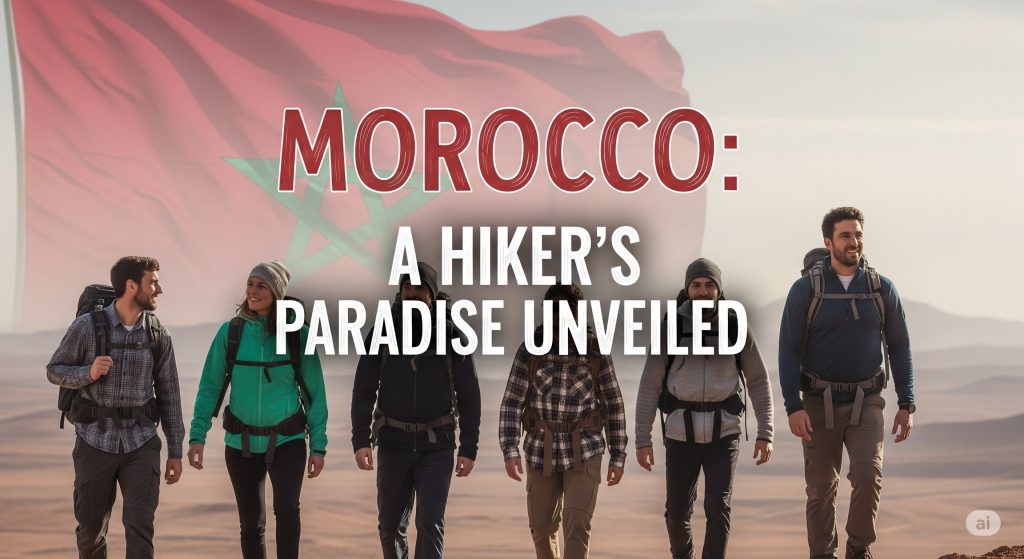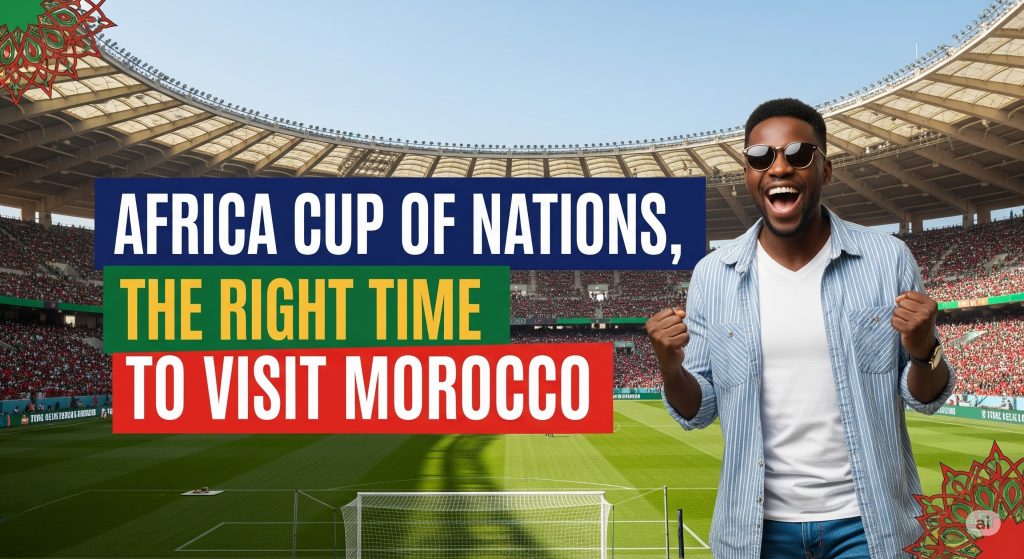Morocco is currently buzzing with anticipation as it gears up to host the prestigious Africa Cup of Nations (AFCON) in December 2025 and January 2026. This major continental football tournament is not merely a sporting spectacle; it is a monumental opportunity for the Kingdom to showcase its rich cultural heritage, modern infrastructure, and vibrant hospitality to a global audience. With strategic investments and a proactive approach, Morocco is set to leverage AFCON 2025 as a powerful catalyst for its already booming tourism sector, projecting record-breaking visitor numbers and a significant economic boost.
Introduction
Morocco has long been a sought-after destination, renowned for its diverse landscapes, ancient medinas, bustling souks, and stunning coastal resorts. In recent years, the country has consistently broken its own tourism records. As of May 2025, Morocco had already welcomed 7.2 million visitors in the first five months of the year, a remarkable 22% increase compared to the same period in the previous year. This impressive performance builds on the momentum of 2024, when Morocco attracted a record 17.4 million international visitors, solidifying its position as the top tourist destination in Africa. The Ministry of Tourism is optimistic that the country could surpass 20 million arrivals by the end of 2025, with AFCON playing a crucial role in achieving this ambitious target. The ultimate goal is to attract 26 million tourists annually by 2030, doubling overnight stays and creating 200,000 new jobs in the tourism sector.
A Strategic Play: Football and Tourism Hand-in-Hand
The decision to host AFCON 2025 has spurred a comprehensive national strategy that merges the magnetic pull of football with Morocco’s dynamic tourism appeal. A landmark agreement finalized in April 2025 between the Royal Moroccan Football Federation (FRMF) and the Moroccan National Tourism Office (ONMT) underscores this synergy. This partnership aims to elevate Morocco’s status as both a premier football destination and a global travel hotspot.
A key component of this strategy is an ambitious European roadshow, which kicked off in Madrid and is making its way through Paris, Brussels, Amsterdam, and Milan. These cities were strategically chosen for their established travel ties with Morocco and their strong football traditions. The roadshow targets not just football fans, but also travel agencies, tour operators, media professionals, and influencers, immersing them in Morocco’s unique cultural heritage, modern infrastructure, and sporting achievements through multisensory events. By using football as a cultural bridge, Morocco is proactively expanding its tourist appeal and fostering stronger connections with Europe’s football-loving public.
Beyond Europe, the campaign also emphasizes South-South cooperation, inviting African tourism professionals and diaspora networks. This reflects Morocco’s growing commitment to regional integration and the development of Africa’s tourism industry as a whole, positioning itself as a catalyst for continental tourism advancement.
Host Cities: Ready to Welcome the World
Six major Moroccan cities have been selected to host AFCON 2025 matches: Casablanca, Rabat, Tangier, Fez, Agadir, and Marrakech. Each city offers a unique blend of history, culture, and modern amenities, and all are undergoing significant upgrades to ensure a seamless experience for teams and fans alike.
- Casablanca: As Morocco’s largest city and economic hub, Casablanca boasts modern infrastructure, including the continent’s third-largest airport and an extensive tram network. The iconic Hassan II Mosque, partially built over the Atlantic Ocean, is a major attraction. The city’s Mohammed V Stadium, with a capacity of 67,000, is a historic venue that has seen significant enhancements.
- Rabat: The capital city is a UNESCO World Heritage site and an imperial city, offering a blend of historical charm and contemporary dynamism. Visitors can explore the Mausoleum of Mohammed V and the Oudayas Kasbah. The Prince Moulay Abdallah Stadium, with a capacity of 50,000, will be a central venue for the tournament.
- Tangier: Strategically located at the crossroads of the Atlantic and Mediterranean, Tangier is a bustling port city. Its Ibn Batouta Stadium has been expanded to a capacity of 65,000, demonstrating the city’s readiness for large-scale events. Tangier’s vibrant medina and stunning coastal views are sure to captivate visitors.
- Fez: Often referred to as the “Mecca of the West,” Fez is the cultural and spiritual heart of Morocco. Its ancient medina, a UNESCO World Heritage site, is one of the best-preserved historic cities in the Islamic Arab World. The Fez Sports Complex, with a capacity of 45,000, will host matches, offering fans a unique cultural experience alongside the football.
- Marrakech: The “Red City” is a perennial favorite with tourists, known for its vibrant Djemaa el-Fna square, stunning palaces, and lush gardens. The Marrakech Stadium, with a capacity of 45,240, is a modern venue, and the city’s robust hospitality sector, with its high concentration of hotels and luxury riads, is well-prepared for the influx of visitors.
- Agadir: As Morocco’s largest seaside resort, Agadir offers beautiful beaches and a relaxed atmosphere. The city’s Adrar Stadium, with a capacity of 45,000, is a key venue. Agadir’s unique blend of Berber culture and coastal charm makes it an appealing destination for fans seeking both football and leisure.
Related article : Discovering Agadir: A Guide to the Jewel of the Souss-Massa Region
These cities are not only upgrading their stadiums but also implementing complementary urban programs. These include improving urban mobility, enhancing infrastructure, redeveloping areas around stadiums, and preparing spaces for welcoming visitors and organizing entertainment activities. Over 120 projects are currently underway across the six cities, all slated for completion before the December 2025 kick-off.
Infrastructure Development and Economic Impact

Hosting AFCON 2025 is an integral part of Morocco’s broader vision for infrastructure development, aligning with its bid for the 2030 FIFA World Cup. The government is investing heavily in expanding airports, improving highway networks, and modernizing rail links, including high-speed trains. This will significantly enhance connectivity and ease of travel for tourists. The ongoing expansion of air connectivity, particularly through low-cost carriers, has been a key driver of Morocco’s recent tourism growth. For instance, Ryanair alone has opened 47 new international routes and 11 domestic ones, with a new base in Tangier, dramatically increasing accessibility.
The economic impact of AFCON 2025 is expected to be substantial. While direct revenues from ticket sales and merchandise are important, the primary economic benefits will stem from the surge in tourism-related spending. This includes accommodation, food and beverage, transportation, local tours, and shopping for artisanal products. The Minister of Tourism, Social and Solidarity Economy, Fatim-Zahra Ammor, has highlighted that major sporting events like AFCON 2025 and the upcoming World Cup 2030 are exceptional opportunities to promote Morocco’s traditional crafts and cooperative economy. The goal is to raise the social economy’s contribution to 8% of the national GDP, creating 50,000 new jobs annually.
Beyond the immediate economic gains, AFCON 2025 will have a long-term positive impact by enhancing Morocco’s global image and positioning it as a capable host for major international events. The modernized infrastructure and improved hospitality standards will leave a lasting legacy, attracting more conferences, business events, and tourists in the years to come. The government’s strategic roadmap aims to reform the hospitality sector, with Law 80-14 introducing new standards for tourist establishments to improve service quality and competitiveness. Initiatives like “Cap Hospitality” are providing financial incentives for modernizing aging hotels, further boosting the sector’s readiness.
Challenges and Opportunities
While the outlook is overwhelmingly positive, Morocco acknowledges the challenges that come with rapid tourism growth. Maintaining the authenticity of local communities and ensuring sustainability are key considerations. The Ministry of Tourism has introduced various sustainability labels, such as “Green Key” certification for hotels and “Blue Flag” recognition for beaches, to foster responsible tourism practices. The focus is on promoting eco-conscious accommodations and tour operators who prioritize environmental stewardship.
Another opportunity lies in diversifying tourism offerings beyond traditional sightseeing. Morocco is increasingly investing in niche tourism segments such as surf tourism, with coastal destinations like Taghazout and Essaouira thriving as international hotspots. Wellness and slow travel, eco-lodges in the Atlas Mountains, and community-based travel packages are also gaining popularity. The country is also attracting digital nomads, with cities like Marrakech and Essaouira developing co-working spaces and nomad-friendly accommodations.
Conclusion
The Africa Cup of Nations 2025 represents a golden age for tourism in Morocco. The combination of world-class sporting infrastructure, a rich cultural tapestry, strategic marketing campaigns, and a welcoming populace positions the Kingdom for unprecedented success. Beyond the excitement of the football matches, visitors will discover a country that is resilient, diverse, and committed to offering immersive and authentic experiences. As the roar of the crowds fills the stadiums of Casablanca, Rabat, Tangier, Fez, Agadir, and Marrakech, Morocco will not only celebrate African football but also proudly unveil its enhanced status as a global tourism leader, setting new benchmarks for the continent and beyond. The legacy of AFCON 2025 will resonate for years to come, solidifying Morocco’s place on the world stage as a premier destination for both sports and travel.
Further read : Top Most Beautiful Beaches in Morocco (Tourist affirmed)
Planning your trip to Morocco ? Contact us now to reserve your seat


Pingback: Tourism in Agadir, The Miami of Morocco - Tasga
Pingback: A Guide to the Jewel of the Agadir Souss-Massa Region